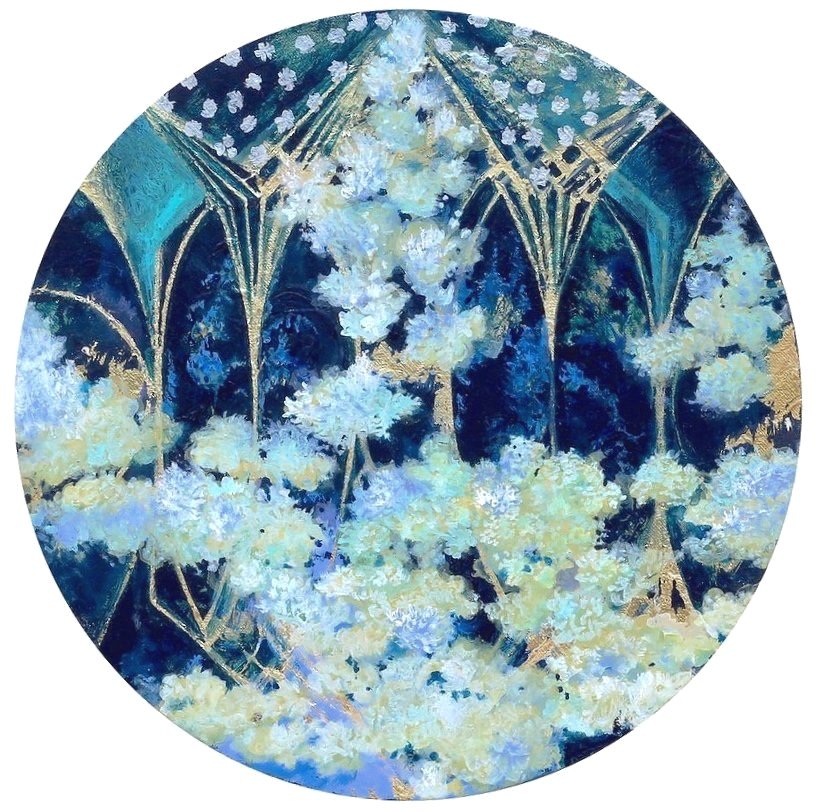Reflections Through the Portal:
Embodied Nature and Relational Ontologies
This collection of painted images investigates how light, materiality, and viewer engagement interplay with embodied nature. This work invites viewers into an exchange where looking goes beyond consumptive observation. The relational dialogue begins immediately through the reflections of the painted surface, allowing it to mirror not only the changing light throughout the day but also the presence and aura state of those who engage with it.
Central to the aim of conversational participation is the use of silver and gold leaf as surface agents. The reflective quality of silver and gold leaf captures and refracts ambient light, creating a dynamic interaction that shifts with the viewer’s perspective. As one approaches the canvas, the surface reflects a blurred image, subtly mirroring the viewer's own presence. This intentional use of materials promotes relational engagement, making the artwork an active participant in a dialogue by forming a connection between the art and the observer. It implies that in viewing the artwork, one is also being viewed, adding layers of interaction and experience. The act of looking becomes an active dance. Through viewer movement, positionality, and perspective shifts, the portal visions alter and transform. Reflection becomes both literal and metaphorical, suggesting a deeper understanding of interconnectedness within ourselves and the natural world.
“Reflections Through the Portal” includes one rectangular painting, Moonflower Love, and a triptych of circular works. They are connected in theme and use of metallic surface, and visually appraise each other as one interconnected body and multiple distinct units. This encourages contemplation of our orientation and sense of our unification and separateness. Relational ontology is examined differently through format; Moonflower Love sets the mirrored foundation, while the triptych uses the multiple to exemplify dialogue.
The triptych structure invites viewers to engage with each portal as an interrelated element of the larger narrative of embodied nature. Each portal serves as a distinct yet interconnected lens through which the viewer can contemplate their relationship with nature, memory, and emotion. The circular form echoes the cyclical patterns found in nature, reinforcing the idea of continuity and interconnectedness, while within each portal are elements of human structure. The portrait of humanity is seen both as the mirrored viewer and through remnants of constructed form. This threefold arrangement emphasizes the relational quality of the artwork itself, prompting viewers to recognize their place within this triadic exchange between the artwork, nature, and their reflective journeys. Viewers navigate from one portal to another and experience an evolving dialogue that mirrors their shifting perspectives and interactions. The triptych format becomes a metaphor for the multifaceted dimensions of existence, illustrating how individual experiences coalesce into a collective understanding that dissolves boundaries and invites shared reflection.
The rectangular Moonflower Love composition incorporates the symbolism of the moonflower, further enriching this dialogue. Moon flowers embody nature's dark beauty with their nocturnal blooming and delicate fragrance. The coupling of the light reflecting silver leaf with the shadow-beauty symbolism casts the spectrum of light and dark in another layer of the relational conversation. The moonflower pigment in the painting contains a glowing agent that illuminates the petals in the darkness, reminiscent of the moonlight that bathes the earth at night. The painting becomes its own light source, drawing from the natural interactions and impressions it captures during the day. The shadow becomes the light. This luminescence not only enhances the aesthetic appeal of the work but also symbolizes memory and resonance—how experiences and interactions with light echo within us.
Geometry is not simply a visual tool; it continues to connect with the thematic, embodied, relational ontologies explored in the series. Moonflower Love suggests the Fibonacci sequence in the vine, which plays a role in the compositional organization of the work; it is a mathematical concept rooted in natural forms that symbolizes growth and connectivity—an embodiment of the patterns found in nature. Incorporating the Fibonacci sequence into the framework creates a composition that harmonizes the natural order with abstract representation, bringing an aesthetic rhythm to the painting that mimics the interconnectedness of all living beings, a central tenet of relational ontologies. Within the triptych framework, the inclusion of the quatrefoil reflects organic growth patterns while suggesting spiritual and architectural significance. Architectural elements that merge with the sublime through verticality serve as a visual gateway, inviting viewers to perceive the artwork as a reflection of both nature and the human experience. The pixelated window panes add contemporary ideas of technological advancement, or even the multifaceted interactions between humans and their natural world. Together, the Fibonacci sequence, quatrefoil shapes, and pixelated windows tell of interconnectedness, emphasizing the ongoing dialogue between nature, art, and human innovation.
This project aims to undermine the conventional boundaries of self and other, shifting the focus towards a co-created experience where nature, the viewer, and the artwork engage in a dynamic relationship. These portals are not just windows into the artwork but invitations to enter a space of reflection and introspection; they are moments where one can contemplate one's relationship with a constructed, reflected nature and form a deeper understanding of one's place within a larger pantheistic notion of existence.
"Reflections Through the Portal" embodies a synthesis of light, nature, and relational engagement. It is an exploration of how painting can break the flatness of its surface, inviting viewers to reflect upon their relationships with the world around them. Through the interplay of silver and gold leaf, moonglow, and geometry, the works resonate with the echoing beauty of interconnected life and the shared experiences that define our existence. By manipulating light, nature, and the intricate dialogues they spark, the work illuminates the profound and the subtleties of the simultaneous realities we inhabit, inviting open conversation about our interconnected existence. We are one.




